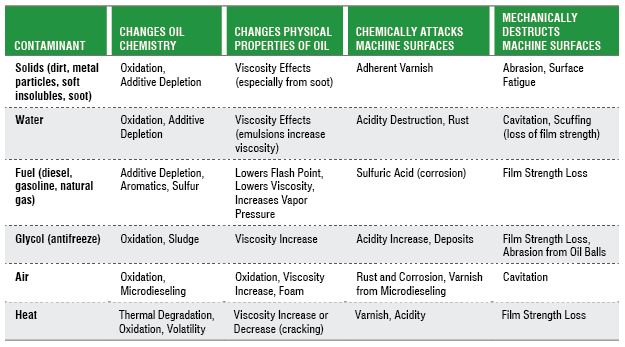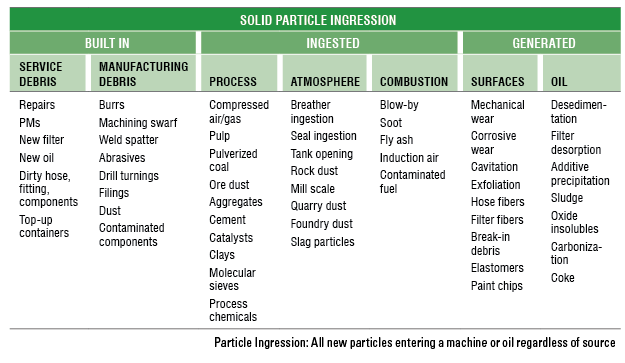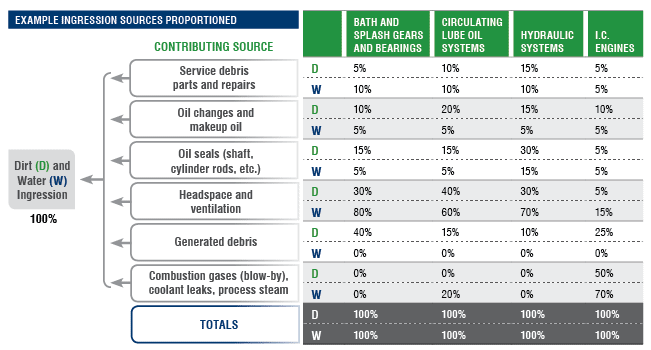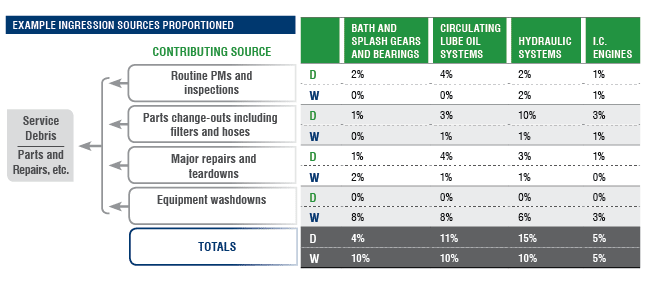Source Contaminants in Your Machines
Source Contaminants control is an important part of a proactive maintenance strategy. The first step in keeping lubricants clean, cool and dry is to address the existing contaminants and measure their potential impact on the machinery and oils (failure modes). With this information, it will be easy to take the appropriate actions to maintain lubricants in good condition.
Generally, the most common contaminants in industry are solid particles (from different sources), water, heat, air and other lubricants (cross-contamination). The chart below offers a summary of contaminants frequently found in oils and the effects they can have on lubricant life and machine reliability.
A wide variety of Source Contaminants may be present in a lubricant depending on the environmental conditions, the specific materials utilized in the production process and the substances existing or generated internally in the lubrication system. Once a list of potential contaminants has been created, it will be necessary to determine their origin, such as whether they are from the environment, from maintenance activities or are generated internally in the machine. This step will be helpful in designing a plan to control the root causes of the contaminants.

Figure 1. Common contaminants in oil and their impact
For example, in an iron-ore mine, you would expect to find greater solid particle concentrations with the typical contaminant reported as iron. In this case, not only would these contaminants likely come from machine wear debris but also from the mineral processed.
In Figure 2, the possible sources of solid particle contamination are identified. A similar exercise should be performed if other types of contaminants are detected in the machines.

Figure 2. Possible sources of solid particle contamination
The next step should be to establish the relative importance of the contaminants and their sources. Ultimately, the best strategy is to focus on the most relevant sources, addressing them according to their significance, to ensure the project will be cost-effective.

Figure 3. Estimated dirt and water contamination by source
In Figure 3, possible dirt and water sources have been addressed for typical machines in a plant, including the estimated percentage of contamination contributed by each source. Good judgment as well as knowledge of the machines, their components, operation and environment will be imperative to estimate these values.
The percentages shown below represent the proportional amount of contaminant generated or introduced to the machine by each potential source. Historical oil analysis information will be very helpful for this purpose. The percentages can also be defined as the probability of being contaminated by each source. In the previous step, the focus was on the amount of contaminants. Now the emphasis is on the contamination frequency. Keep in mind that the percentages for each contaminant must total 100 percent in every machine.

Figure 4. Potential sources of service debris in a machine
A more in-depth analysis will be required to address specific components, locations or the moments at which the contaminants ingress (or are generated) in the machine. Figure 4 illustrates an analysis performed on metallic contaminants that were introduced in a machine as a result of service debris, which was the first contributing source in Figure 3. Analysis of the other possible sources is also recommended to complete this exercise.
A thorough investigation should be conducted to classify the metals that may be present in the oil, such as wear particles (iron, copper, etc.), contaminants (silicon, sodium, etc.), and additives (zinc, phosphorus, etc.). The metallurgy of machine components should be researched to develop a source list of metals and to identify components with potential abnormal wear.
Once the contaminants and their sources have been identified, the next step is to take action to correct the causes, provide the appropriate training, modify the necessary procedures and closely monitor the machines through oil analysis and machine inspections.
This approach offers a practical way to establish the priorities for your contamination control program. Of course, success will depend on the available oil analysis information as well as knowledge of the maintenance procedures and environmental/process contaminants. Finally, be sure to review your methods periodically to improve accuracy and continue your progress in the effective control of contaminants.
Why Micfil Is Right For Your Diesel Equipment
- The Micfil system eliminates water from fuel before reaching the fuel pump and injectors. This prevents the major cause of diesel fuel injection system failure.
- The Micfil system separates solid contaminants from the fuel before reaching the fuel pump and injectors.
- The Micfil system is easily installed.
- Most of the solid contaminants are separated BEFORE reaching the filter element, resulting in less frequent changes the filter element.
PROVEN PERFORMANCE in the laboratory and in millions of miles/hours of commercial and industrial operation. You can be sure that each Micfil unit is designed right, built right and does its job right. CLEAN FUEL provided by a Micfil diesel fuel filter/water separator eliminates nearly all of the engine problems caused by water and solid contaminants in diesel fuel. In addition, you can expect:
- Longer Injection System Component Life
- Full Power Performance
- Lower Element Replacement Cost